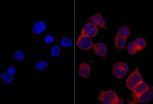(Press-News.org) Chemists in Syracuse University's College of Arts and Sciences have, for the first time, created enzyme-like activity using peptides that are only seven amino acids long.
Their breakthrough, which is the subject a recent article in Nature Chemistry magazine (Macmillan Publishers, 2014), may revolutionize the study of modern-day enzymes, whose chains of amino acids usually number in the hundreds, and of neurological diseases, such as Alzheimer's, which are usually characterized by small clumps of misshaped proteins called amyloids.
Their finding also supports the theory that amyloid fibrils—strong, highly organized fibers, formed by proteins and peptides—may have predated enzymes and triggered reactions that led to some of the earliest forms of life.
"Enzymes fold into unique three-dimensional structures, which underlie their remarkable catalytic properties and contribute to their large size," says Ivan V. Korendovych, assistant professor of chemistry at SU, who co-led the study with William DeGrado, professor of pharmaceutical chemistry at the University of California, San Francisco (UCSF). "Our goal was to prove that much shorter peptides can also achieve well-defined conformations through the formation of amyloid fibrils."
Korendovych and his team designed seven simple peptides, each containing seven amino acids. They then allowed the molecules of each peptide to self-assemble, or spontaneously clump together, to form amyloids. (Zinc, a metal with catalytic properties, was introduced to speed up the reaction.) What they found was that four of the seven peptides catalyzed the hydrolysis of molecules known as esters, compounds that react with water to produce water and acids—a feat not uncommon among certain enzymes.
"It was the first time that a peptide this small self-assembled to produce an enzyme-like catalyst," says Korendovych, an expert in bioinorganic chemistry, biophysics, and chemical biology. "Our finding suggests that amyloids, whose buildup leads to Alzheimer's in the brain, may also have served as the blueprint for larger, modern-day enzymes."
That's good news for researchers such as Korendovych, who thinks this finding may lead to the development of a new class of synthetic peptide-based catalysts. "The amyloid structures we've created may have a more complex biochemistry than we've realized," he says.
There are 20 naturally occurring amino acids, all of which serve as the building blocks of proteins and assist with metabolism.
An enzyme is a type of protein that is composed of at least 100 amino acids and speeds up reactions in a cell.
Korendovych says that, despite an astronomically large number of possible enzymes (each with a different amino acid sequence and three-dimensional shape), only a small number of them actually work.
"Each enzyme has to be an exact fit for its respective substrate," he says, referring to the molecule with which an enzyme reacts. "Even after millions of years, nature is still testing all the possible combinations of enzymes to determine which ones can catalyze metabolic reactions. Our results make an argument for the design of self-assembling nanostructured catalysts."
INFORMATION:
In addition to Korendovych and DeGrado, the article was co-authored by Caroline Rufo, Yurii Moroz, Olesia Moroz, and Tyler Smith, current and former members of Korendovych's research lab at SU; Jan Stöhr, assistant professor of medicine at UCSF; and Xiaozhen Hu, a postdoctoral researcher at UCSF.
Housed in SU's Life Sciences Complex, the Department of Chemistry represents teaching and research opportunities in traditional areas, including inorganic, organic, physical and theoretical chemistry, in addition to programs that cross the traditional boundaries between disciplines, such as biomaterials, bioorganic, biophysical, bio-inorganic, and materials chemistry.
Chemists' work with small peptide chains may revolutionize study of enzymes and diseases
Syracuse University research is subject of major article in 'Nature Chemistry'
2014-04-04
ELSE PRESS RELEASES FROM THIS DATE:
Panel issues exercise recommendations for people with osteoporosis and spine fractures
2014-04-04
Today, experts from the Too Fit to Fracture Initiative presented the results of an international consensus process to establish exercise recommendations for people with osteoporosis, with or without spine fractures. The results were presented at the World Congress on Osteoporosis, Osteoarthritis and Musculoskeletal Diseases in Seville, Spain.
Using the Grading of Recommendations Assessment, Development and Evaluation (GRADE) method, the international multidisciplinary panel examined literature on exercise effects on: 1) falls, fractures, BMD, and adverse events for individuals ...
Does too much time at the computer lead to lower bone mineral density in adolescents?
2014-04-04
Results of a study presented today at the World Congress on Osteoporosis, Osteoarthritis and Musculoskeletal Diseases, showed that in boys, higher screen time was adversely associated to bone mineral density (BMD) at all sites even when adjusted for specific lifestyle factors.
The skeleton grows continually from birth to the end of the teenage years, reaching peak bone mass – maximum strength and size– in early adulthood. Along with nutritional factors, physical activity can also greatly impact on this process. There is consequently growing concern regarding the possible ...
Antioxidants can protect against omega 6 damage -- or promote it
2014-04-04
SAN DIEGO — Given omega 6 fatty acid's reputation for promoting cancer — at least in animal studies — researchers are examining the role that antioxidants play in blocking the harmful effects of this culprit, found in many cooking oils. After all, antioxidants are supposed to prevent DNA damage. But employing antioxidants could backfire, say researchers at Georgetown Lombardi Comprehensive Cancer Center.
In their study, being reported at the AACR Annual Meeting 2015, researchers found that vitamin E actually increased specific damage linked to omega 6 fatty acids. The ...
Light-activated neurons from stem cells restore function to paralyzed muscles
2014-04-04
A new way to artificially control muscles using light, with the potential to restore function to muscles paralysed by conditions such as motor neuron disease and spinal cord injury, has been developed by scientists at UCL and King's College London.
The technique involves transplanting specially-designed motor neurons created from stem cells into injured nerve branches. These motor neurons are designed to react to pulses of blue light, allowing scientists to fine-tune muscle control by adjusting the intensity, duration and frequency of the light pulses.
In the study, ...
UN climate report: Pricing of CO2 emissions critical
2014-04-04
Despite climate change, most polluters still pay little or nothing when they release carbon dioxide into the atmosphere.
'A cost USD 0.15 per kilo CO2 would be enough to solve the whole climate change problem,' says Thomas Sterner, professor of environmental economics at the University of Gothenburg. Sterner is the only Swedish researcher to serve as a coordinating lead author of a new report that the Intergovernmental Panel on Climate Change will present next week.
The third part of Intergovernmental Panel on Climate Change's fifth assessment report, Working Group ...
Flipping the switch on scleroderma
2014-04-04
Scleroderma is a rare and often fatal disease, causing the thickening of tissue, that currently lacks a cure and any effective treatments. A group of researchers, including a Michigan State University professor, is looking to change that.
"Our findings provide a new approach to developing better treatment options where few have existed," said Richard Neubig, chairperson of the Department of Pharmacology and Toxicology in MSU's College of Osteopathic Medicine.
Neubig, along with several of his colleagues from the University of Michigan, have identified the core signaling ...
NASA sees Tropical Depression 05W's bulk west of center
2014-04-04
NASA-NOAA's Suomi NPP satellite passed over Tropical Depression 05W on April 4 at 07:09 UTC/3:09 a.m. EDT. The VIIRS instrument captured a visible picture of the storm, revealing most of the clouds and thunderstorms were west of the center.
The Joint Typhoon Warning Center or JTWC noted that animated multispectral satellite imagery today, April 3, showed that the low-level circulation center is well-defined and that there is fragmented convective banding of thunderstorms wrapping from the north into the southwest, so most of the strongest convection and thunderstorms ...
Researchers probe the next generation of 2-D materials
2014-04-04
As the properties and applications of graphene continue to be explored in laboratories all over the world, a growing number of researchers are looking beyond the one-atom-thick layer of carbon for alternative materials that exhibit similarly captivating properties.
One of these materials is molybdenum disulfide (MoS2), which is part of a wider group of materials known as transition metal dichalcogenides, and has been put forward by a group of researchers in the US as a potential building block for the next generation of low-cost electrical devices.
Due to its impressive ...
Discovery of a mechanism that makes tumor cells sugar addicted
2014-04-04
For almost a hundred years ago is known that cancer cells feel a special appetite for a type of sugar called glucose. The tumor uses this molecule is like the gasoline which depends a sports car to burn faster and grows and multiplies rapidly. It is a little cash process from the energy point of view but allows a superaccelerated cancer cell division. It is what is known as the Warburg effect, which was described in 1927.
Until now little was known about how healthy cells that have a balanced energy consumption depend on this "fast food" calorie in the tumor cell. Today, ...
Vascular changes caused by deep brain stimulation using brain MRI
2014-04-04
Deep brain stimulation has been widely used to treat patients with movement disorders and increasing attention has been paid to its use in the treatment of neurological and psychiatric disorders. However, the influence of subthalamic nucleus or pallidal deep brain stimulation on cerebral vasculature is poorly understood. Even though the metabolic changes caused by deep brain stimulation are being studied using positron emission tomography, the structural changes in cerebral areas like the intracerebral vasculature have not yet been evaluated. Dr. Byeong Sam Choi and colleagues ...
LAST 30 PRESS RELEASES:
The Ceramic Society of Japan’s Oxoate Ceramics Research Association launches new international book project
Heart-brain connection: international study reveals the role of the vagus nerve in keeping the heart young
Researchers identify Rb1 as a predictive biomarker for a new therapeutic strategy in some breast cancers
Survey reveals ethical gaps slowing AI adoption in pediatric surgery
Stimulant ADHD medications work differently than thought
AI overestimates how smart people are, according to HSE economists
HSE researchers create genome-wide map of quadruplexes
Scientists boost cell "powerhouses" to burn more calories
Automatic label checking: The missing step in making reliable medical AI
Low daily alcohol intake linked to 50% heightened mouth cancer risk in India
American Meteorological Society announces Rick Spinrad as 2026 President-Elect
Biomass-based carbon capture spotlighted in newly released global climate webinar recording
Illuminating invisible nano pollutants: advanced bioimaging tracks the full journey of emerging nanoscale contaminants in living systems
How does age affect recovery from spinal cord injury?
Novel AI tool offers prognosis for patients with head and neck cancer
Fathers’ microplastic exposure tied to their children’s metabolic problems
Research validates laboratory model for studying high-grade serous ovarian cancer
SIR 2026 delivers transformative breakthroughs in minimally invasive medicine to improve patient care
Stem Cell Reports most downloaded papers of 2025 highlight the breadth and impact of stem cell research
Oxford-led study estimates NHS spends around 3% of its primary and secondary care budget on the health impacts of heat and cold in England
A researcher’s long quest leads to a smart composite breakthrough
Urban wild bees act as “microbial sensors” of city health.
New study finds where you live affects recovery after a hip fracture
Forecasting the impact of fully automated vehicle adoption on US road traffic injuries
Alcohol-related hospitalizations from 2016 to 2022
Semaglutide and hospitalizations in patients with obesity and established cardiovascular disease
Researchers ‘listen in’ to embryo-mother interactions during implantation using a culture system replicating the womb lining
How changing your diet could help save the world
How to make AI truly scalable and reliable for real-time traffic assignment?
Beyond fragmented markets: A new framework for efficient and stable ride-pooling
[Press-News.org] Chemists' work with small peptide chains may revolutionize study of enzymes and diseasesSyracuse University research is subject of major article in 'Nature Chemistry'




